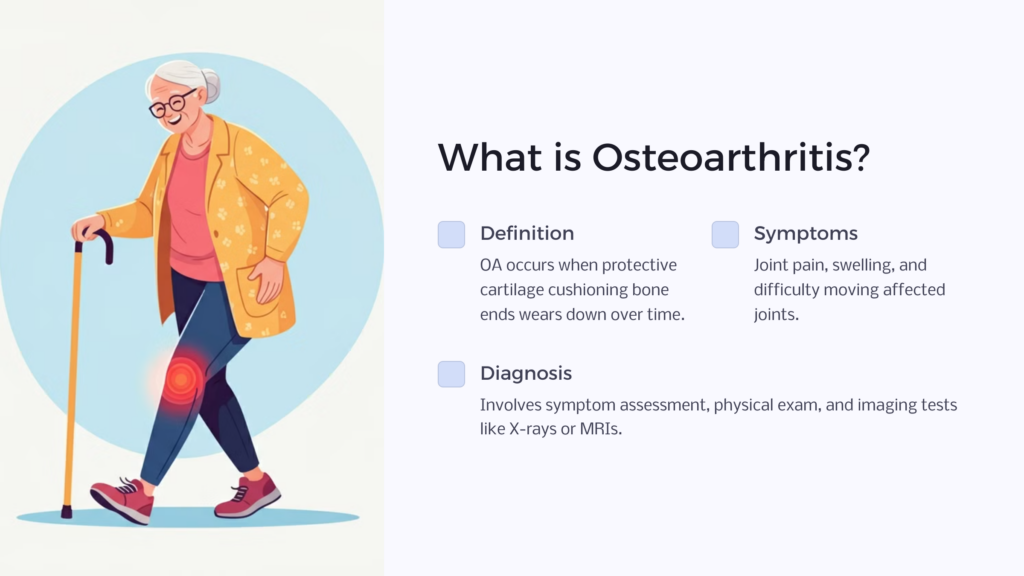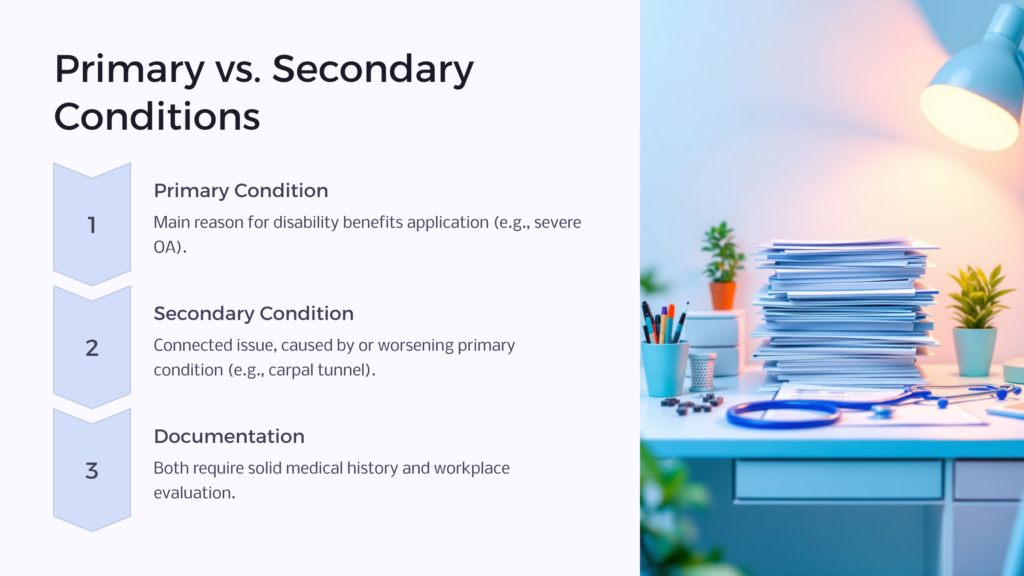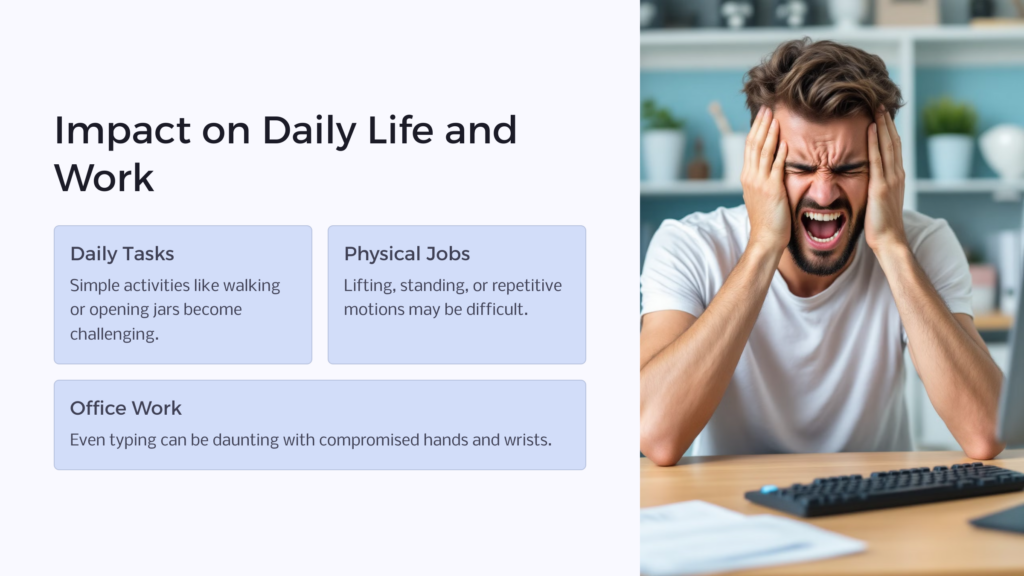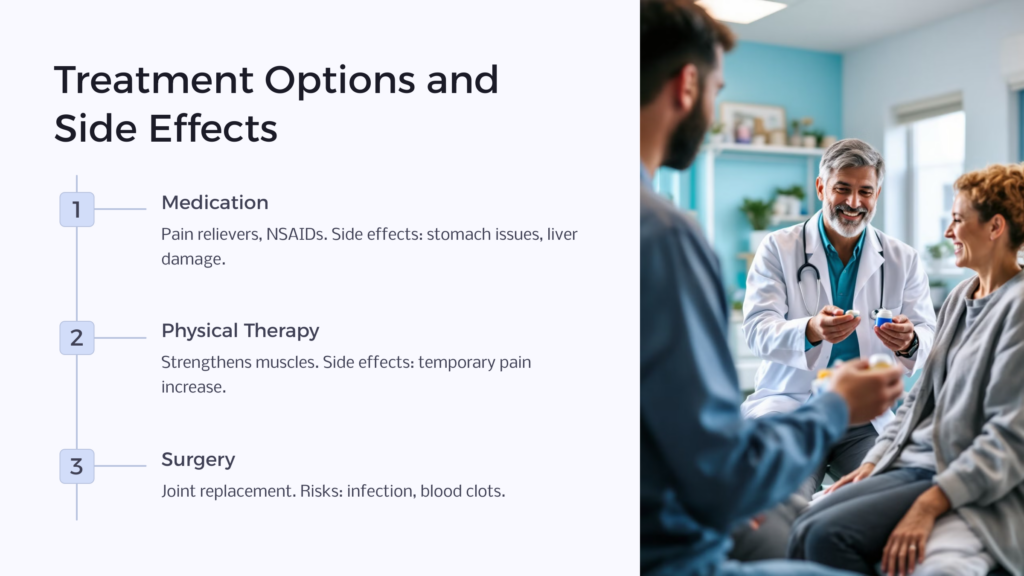Osteoarthritis, often shortened to OA, is a common form of arthritis. It occurs when the protective cartilage cushioning the ends of your bones wears down over time, causing joint pain, swelling, and difficulty moving the affected joint. For some people, the joint pain and limitations are severe—making everyday tasks difficult.

So, how do doctors know for sure that you have OA? First, they’ll ask about your symptoms. Expect questions like; Do your joints ache? Do you hear a grinding noise when moving?
Next, you’ll likely have a physical exam. During this, the doctor will check your joints for tenderness, swelling, or redness through different forms of exercise. X-rays and MRIs can show what’s happening inside your joints, helping doctors confirm if it’s osteoarthritis or something else. (Sometimes, a blood or joint fluid test is also done to rule out other issues).
Is Osteoarthritis Considered a Disability Under U.S. Law?
Osteoarthritis can be considered a disability under U.S. law, but it’s not automatic. The Americans with Disabilities Act (ADA) defines, “A person with a disability is someone who: has a physical or mental impairment that substantially limits one or more major life activities, has a history or record of such an impairment (such as cancer that is in remission), or is perceived by other as having such an impairment (such as a person who has scars from a severe burn).
So, if your osteoarthritis severely limits your ability to walk, stand, or use your hands, you could be considered disabled under the ADA. Paperwork and doctors’ statements are usually the leverage you need to be considered for disability benefits, including OA.
Primary vs. Secondary Conditions: What’s the Difference?

A primary condition is the main reason you’re applying for disability benefits. A secondary condition, on the other hand, is another medical issue that’s connected to the primary one—either caused by it or making it worse.
Let’s say osteoarthritis is your primary condition, severely affecting your mobility. In this case, you’d apply for disability benefits with OA as the main issue. But suppose you also have carpal tunnel syndrome worsened by your OA. In that scenario, the carpal tunnel becomes a secondary condition that, if approved, could give you additional benefits through your disability claim.
But sometimes it’s the opposite: osteoarthritis could be the secondary condition. For example, if you’re a veteran with a knee injury sustained during service, you may develop knee OA years later. If you’re already receiving benefits for the knee injury, the osteoarthritis could be considered a secondary condition qualifying you for more benefits.
Whether primary or secondary, the process for proving your case remains the same. You’ll need a solid medical history, medical documentation, medical records, and likely some workplace evaluation. Collect all the evidence to strengthen your application and prove your medical condition, because when it comes to benefits, the more proof, the better.
Symptoms and Secondary Conditions Tied to OA
If osteoarthritis is affecting you so severely that you’re considering disability benefits, it’s crucial to be aware of all your symptoms—primary and secondary. You’re probably familiar with the common symptoms of osteoarthritis: pain in the affected joints, stiffness, reduced range of motion, etc. But did you know that osteoarthritis can also lead to or exacerbate other conditions?
Conditions like sleep disorders (staying awake from pain), depression, and even obesity (reduced physical activity) can all be tied to OA. Document everything, including how OA affects your mental health or contributes to other physical issues. This documentation will be crucial when applying for benefits through the Social Security Administration. Don’t underestimate the power of a well-documented case; it can make the difference between approval and denial.
Impact of OA on Daily Life and Work

When living with osteoarthritis, simple tasks like taking a walk, climbing stairs, or even opening a jar can become tough. For some, the discomfort is annoying but pain relief is available; for others, it’s a barrier that hinders even basic activities.
So, what about work? If you have a job that requires physical effort—like lifting, standing for long periods, or using your hands a lot—osteoarthritis can make it challenging to meet your responsibilities. But it’s not just physical jobs that are affected. If you’re in an office setting and your hands and wrists are compromised, even typing can become a daunting task.
If osteoarthritis impacts your ability to work to the point where you’re considering disability benefits, you’ll need to demonstrate it with paperwork. Employers’ assessments, occupational therapists’ evaluations, and your own documentation of daily challenges can all help make your case.
What Happens If Osteoarthritis Goes Untreated?
If left untreated, the condition can worsen, leading to even more pain, stiffness, and lack of mobility. And it’s not just about aching joints; if you’re not taking steps to manage your osteoarthritis, you could have more severe health issues. These could range from irreversible joint damage to an overall decrease in physical fitness due to inactivity.
Untreated osteoarthritis can also have a domino effect on other areas of your life. Your mental health may take a hit, as constant pain can lead to stress, anxiety, or even depression. Financially, if you can’t work or your ability to work is restricted, you could find yourself in a tough spot pretty quickly.
Letting osteoarthritis go untreated not only risks your health but can also weaken your case for disability benefits. Why? Well, you’re expected to take reasonable steps to treat or manage your condition. Failing to do so could give the impression that your disability isn’t as limiting as you claim, potentially jeopardizing your eligibility for benefits.
Available Treatment Options (and Their Side Effects)

Treatment for osteoarthritis usually involves medication, physical therapy, and sometimes surgery. Over-the-counter pain relievers like acetaminophen or nonsteroidal anti-inflammatory drugs (NSAIDs) are often the first line of defense. For more severe pain, your doctor might prescribe stronger medication. Physical therapy can help strengthen the muscles around the affected joint, providing better support. In extreme cases, joint replacement surgery may be recommended.
Unfortunately, each treatment option can have negative side effects. Medications might cause stomach issues, liver damage, or even increase the risk of heart problems. Surgery, while often effective, involves risks like infection or blood clots. It’s essential to discuss these side effects with your doctor because they can impact your daily life and even your eligibility for disability benefits. If a treatment’s side effects are making your condition worse or causing new issues, make sure to document this. It’s crucial info for your disability application.
How to Apply for Disability Benefits for Osteoarthritis
If osteoarthritis makes it tough for you to work or get through your day, you might be thinking about disability benefits. Here’s a step-by-step guide to get you started.
First, collect your medical record and any supporting medical documentation. This means anything from your diagnosis and X-rays to prescriptions and doctors’ notes. The more evidence you have, the better your chances.
Next, fill out the required forms. Whether you’re aiming for Social Security Disability Insurance (SSDI) or Veterans Disability Benefits, each has its own set of forms. These documents will ask about your medical history, job, and how osteoarthritis affects your life.
Getting expert advice can help, too. Talking to a disability lawyer or a support group can guide you through the process. They can point out things you might miss and help you avoid mistakes whether applying for Social Security Disability Benefits through the Social Security Administration or VA Benefits through Veterans’ Affairs.
After you submit your forms, get ready to wait. It often takes months to hear back. During this time, you might get asked for more information or need to go through more medical checks. If your application gets denied, you can still appeal. Just act fast; you’ll have a limited time to file an appeal.
So, yes, applying for disability benefits can be a long and sometimes stressful process. But being prepared makes a difference. Gather all your medical evidence and consider getting expert advice. The better your application, the better your chances of getting the help you need.
How Veterans Can Receive Benefits for Osteoarthritis
If you’re a veteran, you have another path for disability benefits through the Department of Veterans Affairs (VA). This can be a big deal if you develop osteoarthritis during or after your service.
First off, link your osteoarthritis to your service. If you hurt your knee in the military and now have OA in the same knee, that’s a direct link. You’ll need service medical records or other proof to show this.
Second, go get a VA medical exam. This is not optional; the VA uses this exam to rate how severe your condition is. The more your doctor understands your struggles, the more benefits you could get.
Third, fill out a VA disability claim form, either online or on paper. Just like with SSDI, stack it with all the medical evidence you have. If you’re not sure about something, reach out to veteran support groups or disability lawyers who specialize in VA claims.
Fourth, submit and wait. You’ll eventually get a letter with the VA’s decision. If it’s a no, you have the option to appeal. But remember, deadlines apply, so don’t wait too long if you’re going that route.
If osteoarthritis is making your life difficult, don’t hesitate to apply for disability benefits. The process might seem daunting, but these benefits exist for a reason—to help people like you get through tough times. You don’t have to navigate the complex application process alone, either. With the right documentation and advice, you increase your chances of getting the financial support you need to manage your condition.
If you’re unsure where to start, we can help at Benefits.com. We’ve been helping people secure the benefits they deserve for years, and we can guide you through each step of the process for free. Don’t let uncertainty or overwhelm hold you back; support and expertise are just a click away. Take that step today to make living with osteoarthritis a bit more manageable.
 Benefits.com Advisors
Benefits.com Advisors
With expertise spanning local, state, and federal benefit programs, our team is dedicated to guiding individuals towards the perfect program tailored to their unique circumstances.
Rise to the top with Peak Benefits!
Join our Peak Benefits Newsletter for the latest news, resources, and offers on all things government benefits.




















